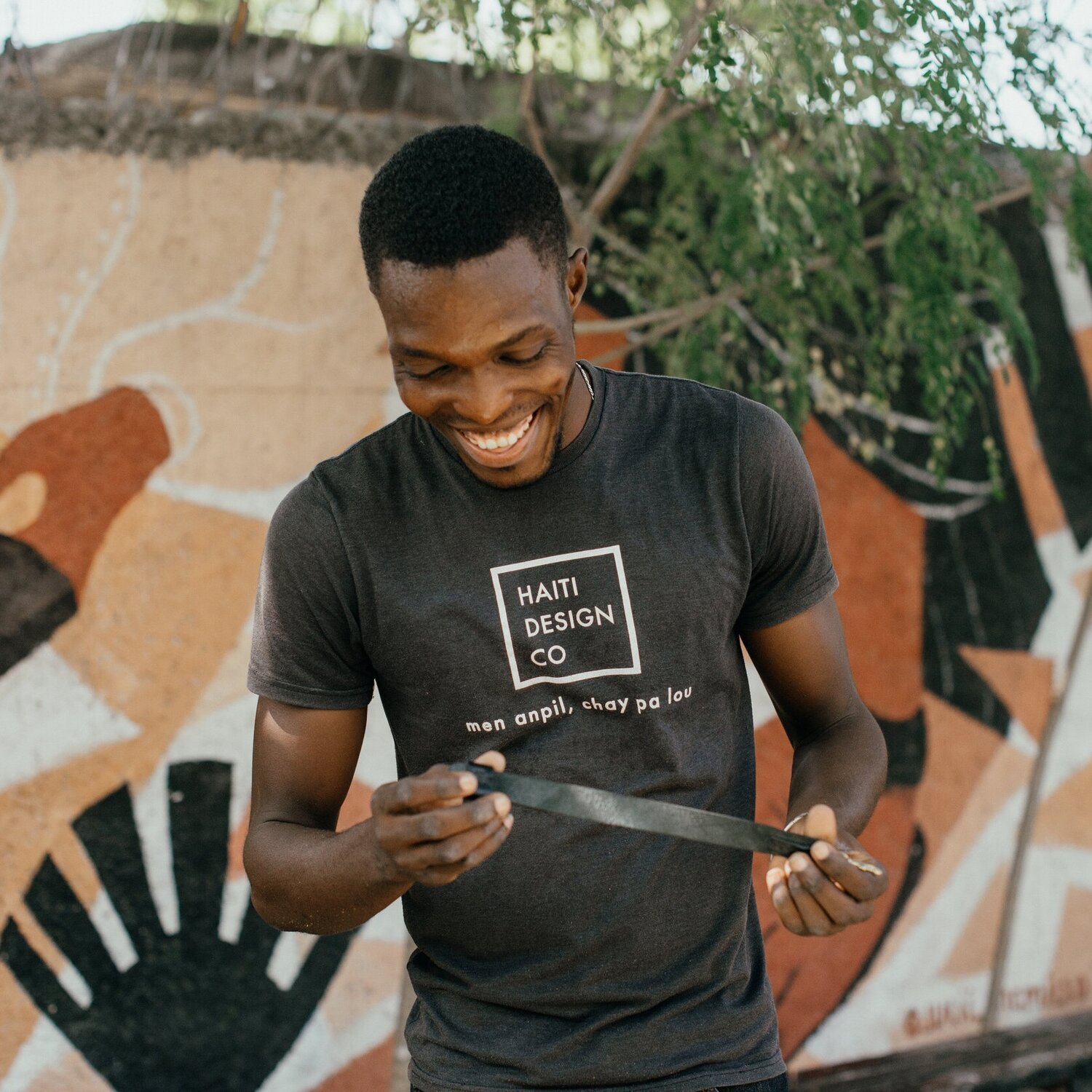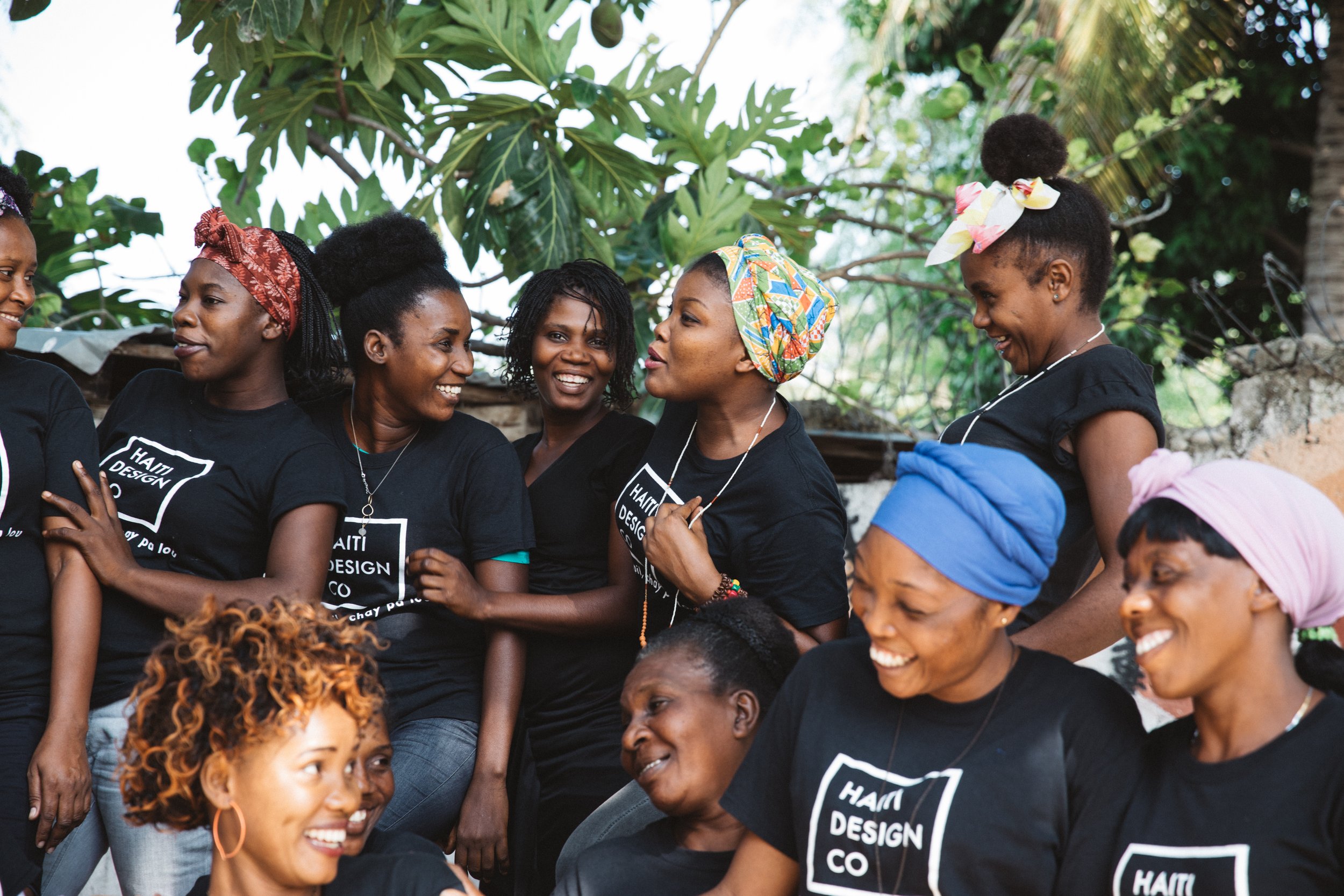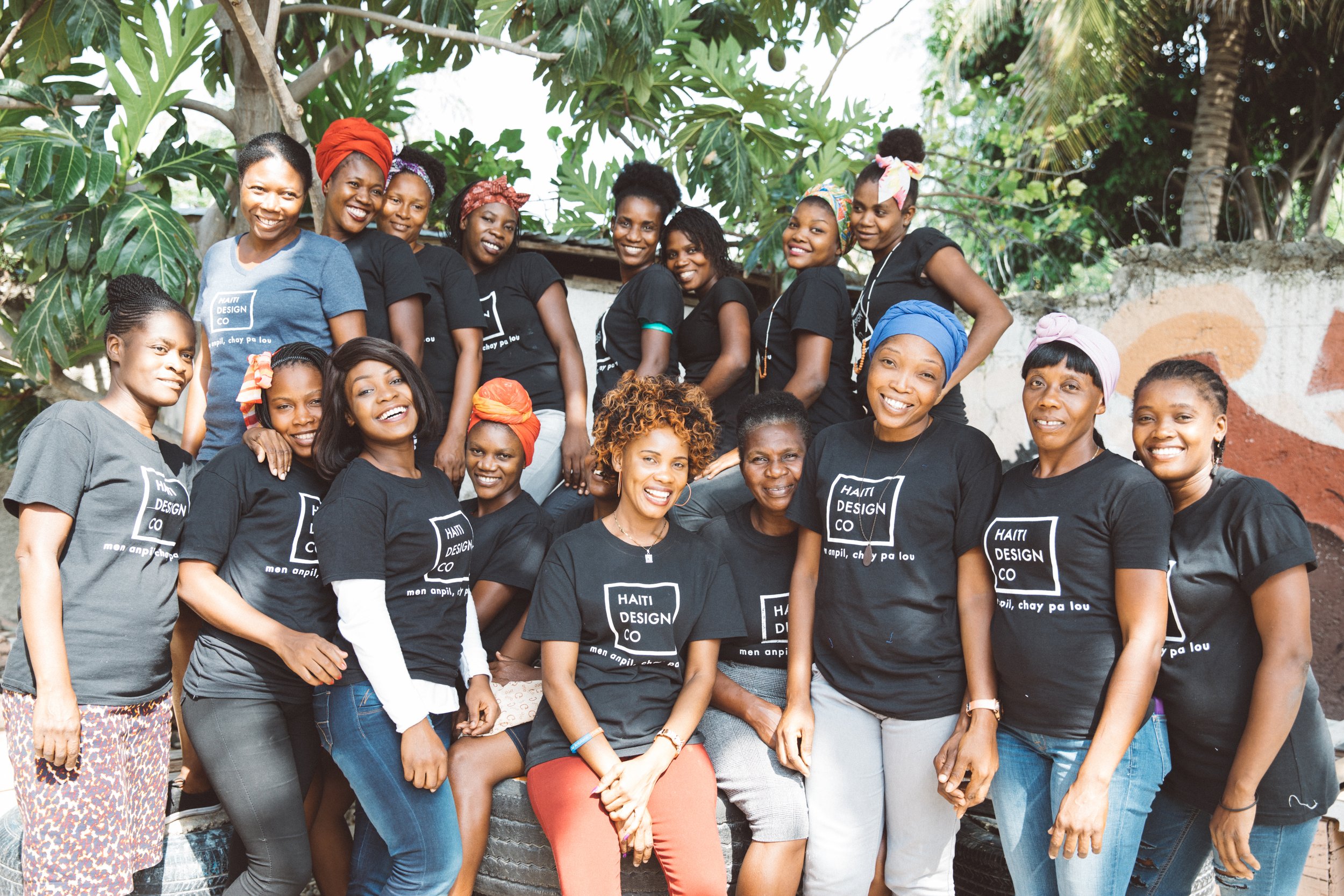All you need as a Monday Mood Booster is a nice pair of earrings from Haiti Design Co and a bomb Haitian Music playlist 🇭🇹 ✨ “Anye” by Tifane always gets Anne-Marjorie up and ready to tackle the day! What is one Haitian song that always boosts your mood?
The "Kenbe - Lage" Tradition and why it's imporant
We love new year resolutions! They are are such a great way to embrace fresh starts but if we are being honest, many of our resolutions are not really sustainable. We tend to keep adding new resolutions to the ones we haven’t even practiced from the previous year.
There is power in simplicity and making sure the goals we set for ourselves are realistic, specific and attainable. Most importantly, it is important to be able to go back to hold goals and habits and do a clean up instead of constantly adding.
Years ago at Haiti Design Co, we started the new year tradition called “Kenbe, Lage” (Hold on, Let Go) where the team gets vocal about what they want to leave in the previous year and what they want to take with them in the new year.
This year was no different. We made sure our staff took the time to vocalize what they wanted to leave behind and what they are looking forward to for 2022.
No need to say it has been quite a challenging year for us and now more than ever, we need to keep our hope and faith up. We want to encourage you to do the same. No matter where you live or your circumstances, remember that as long as there is life, there is hope and things to look forward to and let go off.
Here are some of our artisan’s resolutions for 2022
Mwen vle kite selibatè pou 2021. Mwen vle kite tout move panse negatif yo ki te konn fè mwen pè pou mwen avanse. Nan ane 2022 a, menaj men avèm ap pran dispozisyon pou nou prepare maryaj nou
I want to leave all of the negative thoughts that used to keep me stuck. I also want to leave the single life behind. In 2022, my boyfriend and I are taking action to plan our wedding
- Maxanne -
Pou 2021, map kite epav, paresès. Sa yo Konn fè mwen pa verman ekonomize kòb mwen. An 2022 map kenbe disiplin pou mwen kapab travay pi byen epi pou mwen kapab fè ekonomi
In 2021, I leave laziness and procrastination. Because of these I often don’t make proper money savings. In 2022 I am keeping a spirit of discipline in order to work better and also save my money.
- Kavakia -
We are wishing you the best for 2022!
may this be your best year yet…
THERE IS NO HAITIAN NEW YEAR WITHOUT SOUP JOUMOU
HAITIAN NEW YEAR TRADITION : SOUP JOUMOU OR INDEPENDENCE SOUP
January 1st is such a special day for the Haitian community. Not only because it marks the start of a new year but most importantly, because on January 1st, 1804 Haiti made history by being the first Black republic in the world and the first country in the Western Hemisphere to abolish slavery.
On this day, you can be sure that every Haitian family will be found enjoying the traditional independence soup: Soup Joumou, which is our symbol of freedom and independence.
Why soup joumou? Well the story behind it is, slaves were not allowed to drink the soup during slavery days. It was a meal reserved for French masters. When Haiti defeated the French and won their Independence, they gave this previously forbidden food a whole new meaning. The soup became a symbol of Haitian independence and freedom.
Whether you like your soup Joumou vegetarian or full of meat, with pasta or without, there are so many different ways of making this delicious soup, which shows our beauty and diversity!
We had the chance to sit with Gaëlle Lissade, a Haitian food lover and connoisseur now living in Europe. She not only talks about her passion for cooking but also about how she lives Haitian Independence Day in her kitchen!
My name is Gaëlle Lissade, founder and creative mind behind Come over I’ll make dinner. A unique dinner experience concept, inspired by Haitian dinner traditions. I was raised in Haiti and immigrated to the US to attend college in 2010, where I studied Political Science. I have spent the past few years, working in diplomacy. And as of recently moved to Germany from the UK.
I always find it so interesting when someone asks me when my love of cooking started. Honestly, I can’t remember. Food has been such an integral part of my life since my younger years. My grandmother and my godmother both cooked and baked professionally, and of course my mom is to date the best chef I know. I’ve always been surrounded by food, and I loved that, I loved being in the environment, tasting and watching. But I do know that my love of cooking steamed from my love for dinners.
I loved Sunday dinners around the table, or just going out to eat with friends and family. From there it turned into me wanting to participate in those happy moments. I started going to the kitchen and learning hands-on all the intricacies of home-cooking from my mother and our cooking-maid. And that was it! I made a shrimp tart, as my first meal and that was it, I was hooked!
What does Independence Day mean to you, as a Haitian cook?
Well, first being Haitian, it’s the premise of our history, conquering adversity to the path of freedom, tradition and family. As a Haitian cook, I think it’s the day to cherish and translate that history and tradition, to commemorate and pay homage to those that have paved the way for us to be here today. It’s the first day of the year where we bring people together around our “Soup Joumou” and an opportunity to share our culture with the world as a part of our founding fathers’ vision for our nation to be the lighthouse of freedom and unity.
When did I learn to cook Soup Joumou?
Like I said earlier, I don’t really have a clear memory on when I learned to cook. Since it is such a staple in our households, on January 1st or just on Sundays’ I’ve always really observed and from there when it came time to do it, I tried using the techniques I’ve seen my mom use and made it from there. But again, honestly it wasn’t until recently that I feel like I’ve successfully mastered the art of making a hearty Soup Joumou
Can you share your recipe?
Of course, but I don’t want to take the entire credit since this is my mother’s recipe with a few modifications to make it accessible to the international crowd. Soup Joumou is laborious, but an absolute sign of love and absolutely worth experiencing.
Ingredients
2 slices of Giraumont / Winter Squash
4/6 carrots roll cut
½ of a white cabbage + 1 Cabbage leaf
2 radishes peeled and cubed
6 russet potatoes cut in cubes
¼ Malanga and ¼ yam (Optional)
3 Cloves, poked into a green scotch bonnet pepper (Not optional)
2 Culantro (Shado Beni) leaves and thyme**
Seasonned Beef Shanks*
½ cup of macaroni
1 leek
½ onion chopped
Preparing the Beef Shanks*
Wash and clean your beef, using the traditional method, or treat to your liking. Pat dry and add in your Haitian seasoning, mustard, a little sprinkle of adobo (until the ancestors ask you to stop), hot sauce, salt and a few sprigs of fresh thyme. Massage the mixture into the meat and let rest at least 30 minutes. (This can also be prepared and left in the fridge overnight)
In a medium to hot pan, add 1 tbsp of olive oil, and your beef. Brown on all side and reduce the heat and cover. The juices (sauce) that will be created with this steaming will bring a depth to the soup
Picture Credit @Msavorythoughts
Preparing the Soup
Peel your Giraumond, clean and remove the seeds along withany extra strings. Once cleaned, add the vegetable to a pot of water and bring to a boil until it softens.
Once it is done cooking, remove the giraumon from the pot and place it in your blender, using some of the cooking water continuously until it becomes well diluted.
Using a strainer, pass the mixture in your stock pot. Add more hot water as necessary to help extract the rest of the giraumondfrom the strainer.
Bring your stock pot to a medium-high boil. Add in your carrots, radish, leek, the cloves and green scotch bonnet.
Using a cooking thread, tie together the thyme and Culantroleaves, then wrap them in 1 cabbage leaf. Add the rolled cabbage leaf into your stock pot. Note that it must be removed before serving.
Cover, and leave on a medium-heat for 15 minutes or until vegetables have soften and are fully cooked.
In the meantime, remove beef shanks from the heat.
Once the carrots have cooked, slowly add in the pieces of beef, potatoes, malanga, yam and macaroni. Stir occasionally to avoid clumping of the ingredients. Cover and let simmer on low/medium heat for 20 minutes.
If the soup thickens more than you would like, add in some hot water.
And now for the secret ingredients
In a hot pan, add in some olive oil and add in chopped onions. Cook until brown and caramelized. Using one ladle, pour your soup mixture (just the liquid) over the onions. Immediately turn off the heat.
Using a strainer, strain the soup and onion mixture, adding it back to the big pot of soup. This is an absolute game changer.
Give it a good mix, correct your seasoning accordingly and it’s ready to serve. Of course, with some warm Haitian bread and butter!
What special touches do you add to your soup?
The caramelized onion part of my recipe is absolutely what elevates the flavor of the soup in contrast to the other soups of the world. The process is referred to as “Commander” and it absolutely adds a great layer of sweetness and depth.
Favorite thing about being Haitian?
Our gastronomy! I think I can unbiasedly say that Haiti has one of the best foods in the world, and that’s one of my goals with Come Over I’ll Make Dinner, to invite people to experience this amazing food the way it should be, with amazing flavors and surrounded by friends and family.
Make sure you stay in touch with Gaëlle and the magic she creates in the kitchen by following @comeoverillmakedinner.
VALUING HAITIAN ART AND SELF-EXPRESSION
VALÈ SERIES PART 2 WITH JULIE ORELIEN HERNANDEZ
I am Julie Orelien-Hernandez, a content creator and teacher. I was born and raised in Port-au-Prince, Haiti but now reside in the Bronx, NY. I am pretty drawn to the arts, be it painting, drawing, creative writing, or looking at different art museums and galleries. I believe I got this trait from my mother, whom I discovered, was into the arts as a young woman. At seven years old, I remember finding her notebook full of fashion design drawings that she had created, which inspired me to explore these forms of illustrations. Interestingly, she didn’t quite have that art exploration with my sisters and me growing up. I was definitely inspired by the tap-tap paintings and the canvases hung by the streets in Haiti.
“For me, Haitian Valè means regarding Haiti and it’s culture with value.”
As Haitians, we tend to diminish our values and place American values above our own. I cherish certain things in our culture that I cannot find in the U.S. When I lived in Haiti, since everything was available to me, I didn’t necessarily understand its importance. As I moved to the U.S., I understood what it meant to not have some djon djon in my pantry to make some diri djon djon or not eat some lalo or some fresh Ju Korosòl. I not only missed the food but the language.
When I came to the U.S., I was surrounded by people who only spoke English, and it reminded me of how much I missed and appreciated my language. When I find people who speak my language, my heart rejoices, and I communicate in my mother language.
I am a preschool teacher, and art is embedded in the curriculum. I love that I get to explore art with children and experience how they freely express themselves through that medium. It has given me more confidence to just play with paint as I express myself.
“Now that I am pregnant with my son, I want to share those cultural traditions with him: food, language, or art. ”
I enjoy making representational drawings and paintings of people and objects. That’s my forte. When I am stressed or overwhelmed, besides going to God to meditate, art is my other method of relaxation and therapy.
I don’t have a specific artist who has impacted my journey. Still, I remember seeing paintings of life scenes in Haiti, like people going to the maché; machann selling or caring their baskets on their heads, landscapes capturing Haiti’s greenery and mountainous lands. I love the way people are portrayed in paintings as faceless, like a silhouette with their clothes. I have included these attributes in my drawings of people. I also enjoy landscapes and nature paintings. It inspires me to notice the beauty around me, be grateful for living, and apply it to my paintings.
Click below to watch this video where Julie explains why it’s important to her that her son knows more about Haitian Value.
TO LEARN MORE ABOUT JULIE, FOLLOW HER ON @MINIMAL.JULES
Introducing… The VALÈ SERIES
What comes to your mind when we talk about Value ? In the practical sense of the word, to value something means to cherish it and to acknowledge its importance. We can recognize the beauty in something but not cherish it enough…not give it the respect it deserves. Many of us Haitians feel like this when it comes to our heritage. Whether we talk about our food, our art, our people or our language, we cannot help but feel like many things in Haïti are treasures many cannot seem to see. Could it be that the reason for this is that we do not Value them enough?
The series Valè aims to do just that: Diving into different aspects that we love most about Haitian culture. The people, the history, the oral traditions that make up valè nou.
We had the chance to collaborate with Anne-Marjorie René, an audio-visual storyteller who is dedicated to promoting Haïti through her creations. Let’s read more about what she has to say has she explains why she values small Haitian businesses so much.
PART 1: Valuing Haitian Entrepreneurs
I am Anne Marjorie René, a creative entrepreneur and visual storyteller. I was born and raised in Port-au-Prince but I am a country girl at heart. I come from a lineage of machanns and artisans and I am passionate about storytelling, community building and economic development.
Haitian Valè for me is a combination of things that make our essence. Part of our heritage and identity that we thoughtfully pass down from a generation to another. I value so many things about our culture and the way we function as people. I love how small business owners like to include God’s names and attributes in their business’s names, I love how the traveling street vendors make entertaining songs that they sing out loud to market their products, I love how content most of us are, it is beautiful to see how happy and resourceful we can be with so little while cultivating generosity .
I love to serve my community with my gifts, being able to connect people while creating opportunities for them. I am humbled to tell their stories to the world, to shine light on our true colors and show our bright side.
I believe that entrepreneurship is one of the key tools to foster economic development. Our community revolves around enterprises that meet almost all of our needs and give us the solutions to our problems. Leveraging entrepreneurship will make our community economically viable and it potentially bring stability. Entrepreneurship can easily take Haiti from aid to trade.
I grew up around so many entrepreneurs who impacted my life in a special way.
Frantz Jean-Ba is an artist I met a few years ago at place Saint-Pierre; he makes beautiful paintings that move me. He also has a stand where he sells arts and crafts for other artisans who cannot afford to have their own stand. It’s one of my favorite places to shop for unique gifts. We see each other from time to time and I stop by just to say hi even when I am not buying. Fritzner and Miguelito are my flower pratiks ,they are always one call away and they make me the most beautiful bouquets for me and my loves ones.
Antoinette is a vegetables machann that I have known since forever; she used to be my father’s favorite “Pratik” and now she is mine. I admire her perseverance and courage. One thing I’ve learned about her is that “Will is power “she likes to say “Depi w vle ou kapab” . She had to start over with her business multiple times because she is a single mother who could not afford to let her family down. Now that her kids are older they turned her vegetables basket into a family business.
I am intentional about buying local because I want my money to recirculate and in my community, the small business owners are less likely to leave to go somewhere else . It brings me joy when I am able to encourage local prosperity. At my local market I get to pick my fresh food and I know where it comes from. I am a sucker for handmade things and crafts, buying from my local artisans help them to stay and guarantee their ability to provide for their families.
Click here to watch Anne-Marjorie’s video for the Valè Series honoring Haitian small business owners.


















